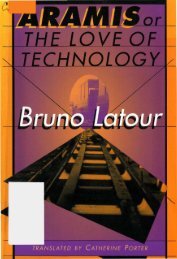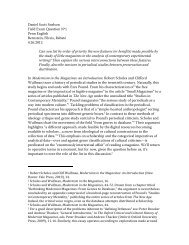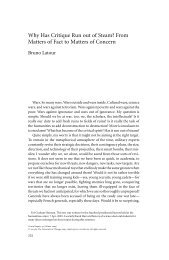The Exploit: A Theory of Networks - asounder
The Exploit: A Theory of Networks - asounder
The Exploit: A Theory of Networks - asounder
Create successful ePaper yourself
Turn your PDF publications into a flip-book with our unique Google optimized e-Paper software.
Nodes 67<br />
As a concept, swarming derives from biological studies <strong>of</strong> social<br />
insects and their capacity to collectively carry out complex tasks:<br />
the construction <strong>of</strong> a nest by wasps, the coordinated flashing among<br />
fireflies, the cooperative transportation <strong>of</strong> heavy loads by ants, the<br />
global thermoregulation <strong>of</strong> a nest by bees, and so on. 36 Each <strong>of</strong> these<br />
examples illustrates the basic rules <strong>of</strong> biological self - organization,<br />
how a set <strong>of</strong> simple, local interactions culminates in complex, collective<br />
organization, problem solving, and task fulfillment. In philos -<br />
ophy, the relationship between humans and insects far predates such<br />
scientific studies: Aristotle, in calling the human being a “political animal,”<br />
made a direct contrast to the insect; Hobbes stressed the human<br />
capacity to emerge out <strong>of</strong> the “state <strong>of</strong> nature” through the giving up<br />
<strong>of</strong> rights to a sovereign, a capacity lacking in insects; Marx acknowledged<br />
the capacity <strong>of</strong> insects to build but emphasized the human capacity<br />
for idealization as part <strong>of</strong> their “living labor”; and Bergson,<br />
expressing a poetic wonder at the ability <strong>of</strong> insects to self - organize,<br />
suggested that evolution was multilinear, with human beings excelling<br />
at “reason” and insects excelling at “intuition.”<br />
<strong>The</strong>re is an entire genealogy to be written from the point <strong>of</strong> view <strong>of</strong> the<br />
challenge posed by insect coordination, by “swarm intelligence.” Again<br />
and again, poetic, philosophical, and biological studies ask the same question:<br />
how does this “intelligent,” global organization emerge from a myriad<br />
<strong>of</strong> local, “dumb” interactions?<br />
Arquilla and Ronfeldt also ask this question, but they limit their<br />
inquiry to military applications. Building on the military - historical<br />
work <strong>of</strong> Sean Edwards, their analysis is ontological: it is about the relationship<br />
between enmity and topology. <strong>The</strong>y distinguish between<br />
four types <strong>of</strong> aggregate military diagrams: the chaotic melee (in which<br />
person - to - person combat dominates, with little command and control),<br />
brute - force massing (where hierarchy, command formations,<br />
and a battle line predominate), complex maneuvers (where smaller,<br />
multilinear, selective flanking movements accompany massing), and<br />
finally swarming (an “amorphous but coordinated way to strike from<br />
all directions”). 37 While elements <strong>of</strong> each can be found throughout<br />
history (horse - mounted Mongol warriors provide an early swarming









